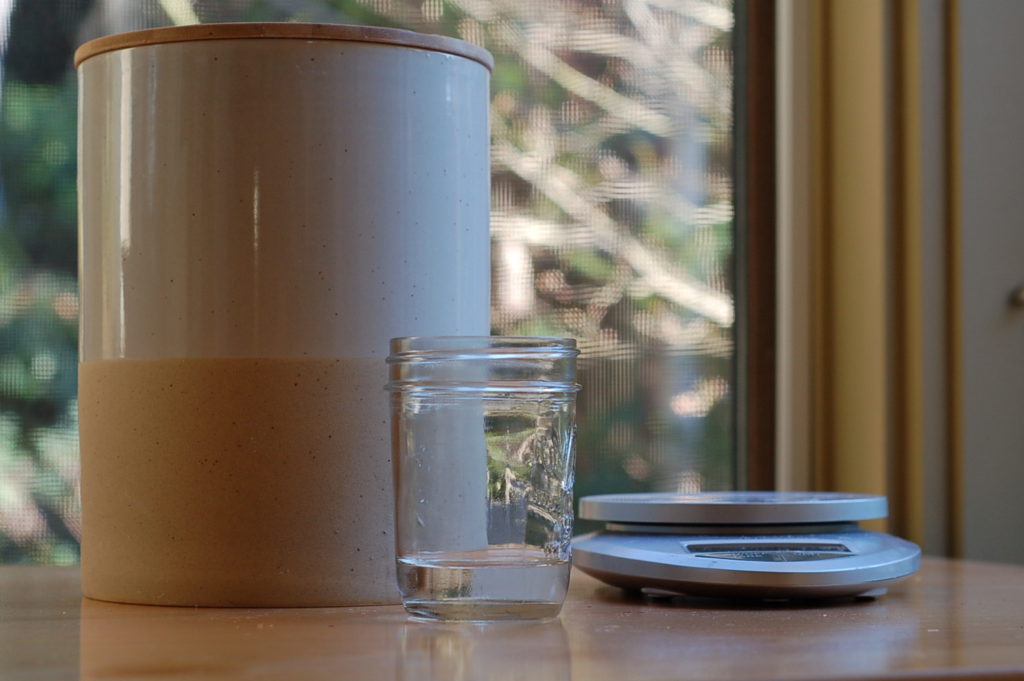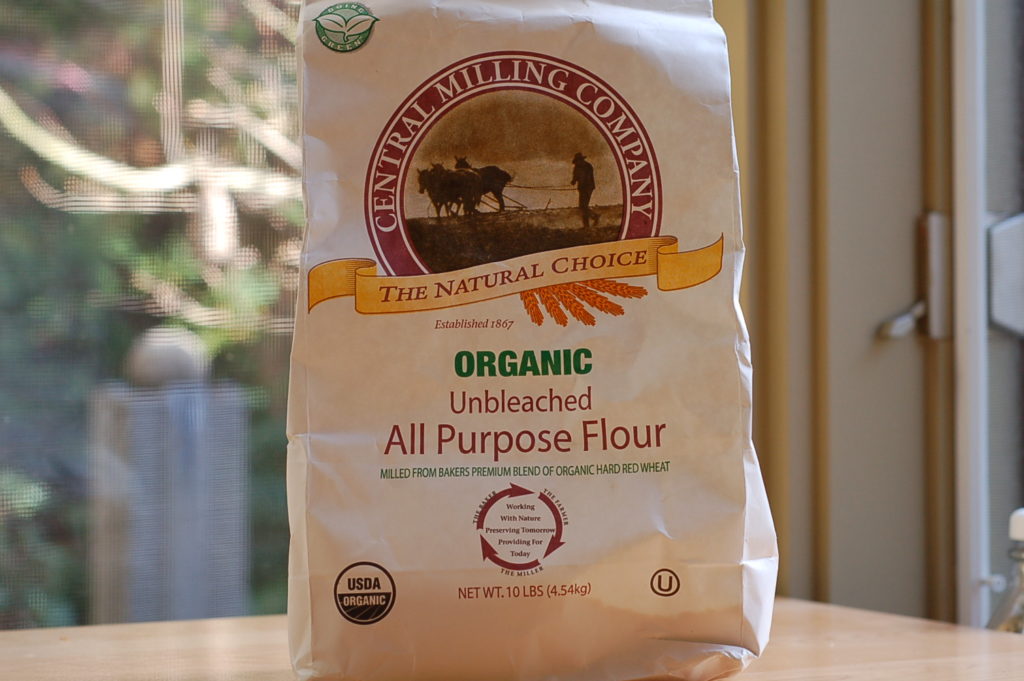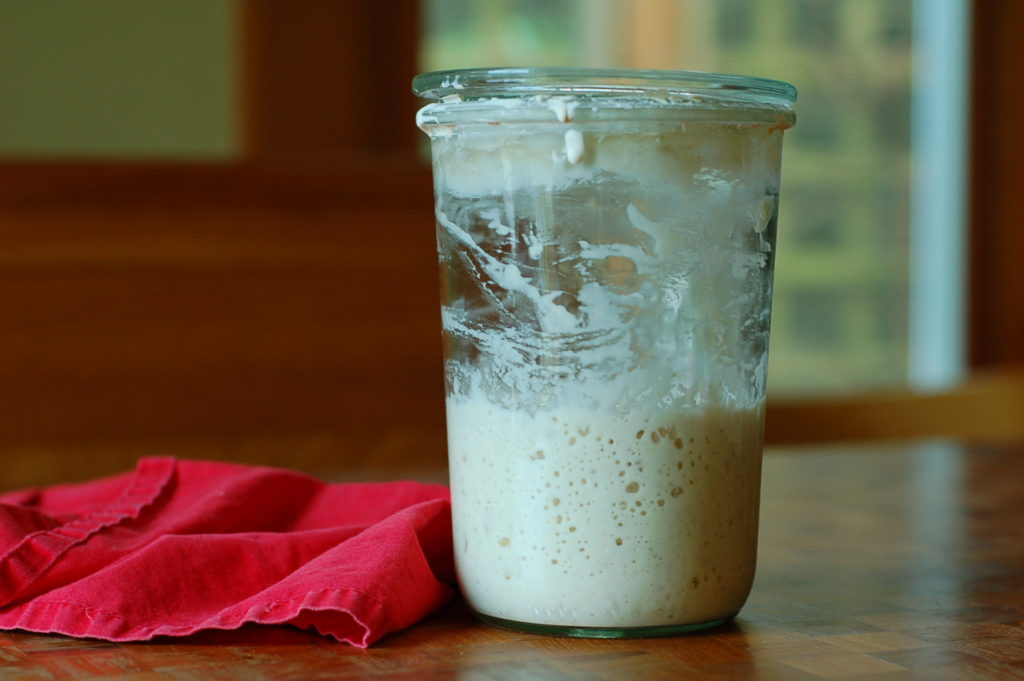Get your sourdough starter on

Oh bread! Glorious bread. When I was a kid, my dad brought home fresh loaves of granola bread every week from the Portuguese Bakery in Nashua, New Hampshire. I lived on the stuff. It was wholesome, a little bit sweet, with a chewy, thick crust and perfectly moist crumb. My daily lunch consisted of a peanut butter and honey sandwich on granola bread. It was especially good when my mom packed it first thing in the morning, because when I opened it at my desk at school, the honey had crystallized and merged into the crevices of the bread, making for a perfect, delicately crunchy, sweet explosion with each bite. That bread was so good.
My adoration of bread may have started even earlier, now that I think about it, when we would visit my dad’s family in Pennsylvania, and my great aunt Marian would make the most wonderful, fluffiest loaves of plain white bread. I was never allowed to eat such things (my mom did not consider WonderBread and its ilk a real food), so when my great aunt would pull it out of the oven, I could not possibly get enough. I remember thick slices slathered in butter and the distinct feeling that I could always eat just one more piece.
At some point, my dad switched jobs, the bakery was harder to get to, and we stopped getting that granola bread, and we must have eating something in the interim, but I don’t remember what. Then one day my mom brought home a loaf of When Pigs Fly bread from the grocery store. It became a new staple in our house. She would get the Tuscan wheat and the sourdough, and most mornings I had a great internal debate about which I would have for my breakfast toast. I still have the same debate whenever I visit my folks.
After college, I spent three years living in Switzerland, and basically buried myself in mounds and mounds of proper French artisan bread. I spent many a weekend at the farmer’s market in Ferney-Voltaire, just across the French border from Geneva, where I was living. No one does bread like the French, and I worked my way through beautiful baguettes, modest boules, hearty pain de campagne, substantial batards, and literally any other gluten-based substance that appeared before me. I’d eat it plain, slathered in butter, with jam, or, especially, with a hunk of one of the zillions of magnificent Swiss and French cheeses we kept stocked in the kitchen. Bliss.
It never occurred to me that maybe I could make something equally worth eating.
When I was pregnant with my first kiddo, in 2010, the nesting got a little bit out of control. I stopped working about six weeks before the bub arrived, and I spent almost all of that time reading any easily digestible novel I could get my hands on, lounging on my yoga ball not actually doing any yoga, and baking whatever I felt like eating. I mostly felt like eating bread, so I dabbled with the five minute a day artisan bread method. I used the book by Jeff Hertzberg, and it was pretty good. Not amazing, but pretty good.
Then I had a kiddo. And then a few years later, I had another. The idea of making bread regularly – even if it took only five minutes a day – was laughable. Instead, I shelled out for tasty loaves from the lovely local bakeries in Seattle, often the pre-sliced multigrain loaves from Essential Baking Company, sometimes one of the round boules or pointy, crunchy baguettes from any of the other wonderful bakeries around town (Macrina is a real favorite in this household).
Then last year, for some reason, I got it in my head that maybe I could give sourdough a try. I knew absolutely nothing about the process, and had no sense of what kind of time commitment it would require, but one day I did a little reading, and on that whim, I started Sadie the Sourdough Starter. And I haven’t looked back. Turns out, making delicious sourdough bread is totally in my wheelhouse. And it could be in yours as well.
To make my starter, I used the method outlined on the Kitchn by Emma Christensen. It’s worked a treat for me, from the very start. I also helped my mother-in-law start a starter while visiting her in Melbourne, and whatever we did first did not work. It died. So we tried again, with some modifications, and it worked. Other than halving the quantities, this is basically exactly the method from the Kitchn, and I’d recommend reading that link for a more thorough discussion of how it all works if you are interested in that kind of thing.
If you know nothing about sourdough – like me last year – the following will seem like a joke.

Sourdough starter
Ingredients
- 2 ounces unbleached all purpose flour
- 2 ounces water
Instructions
-
Mix flour and water in a jar. Scrape the sides. Loosely cover.
-
The next day, add another two ounces of water and two ounces of flour. Stir well, scrape down the sides. Cover again. Repeat for the rest of your life.
I KNOW. It’s like magic. HOW? It’s all about wild yeast, which is all around us, on our hands, in the air, in the flour. Given a little time, it will start to multiply in your starter concoction, and as long as you keep feeding it – just with more flour and water – it will stay alive and be robust enough to make those lovely big bubbles in your bread dough. Every day, just add another 2 ounces of flour and 2 ounces of water (or some other measurement that works for you of equal parts – by weight – flour and water). After a couple of days, you should start seeing some bubbles and start smelling a little ferment. By the end of the week, you should have a happy, active starter. If it gets too full for your container, you can dump some out into your compost, or, preferably, find a use for it. Surprisingly, actually making artisan bread is not a major use as it requires very little starter, but there are oh so many other things to do with it. Head over to the sourdough page to get some other ideas.
Once your starter has been going for a while, you can cut back on the feedings to every couple of days. You can also store it quite happily in the refrigerator for extended periods, feeding it every week or so. Then when you are ready to use it, you take it out a day or two ahead of time and feed it to get it back up to strength. This is a lifesaver when I travel, as I have a designated Sadie Babysitter, and nothing untoward has happened to her. She’s happy as can be.
I buy my all-purpose flour at Costco and couldn’t be happier with it. It is organic and comes in a very affordable 10-pound two-pack. If they ever stop carrying it, I will be adrift.

I also use filtered water, because a water filter came with our kitchen sink when we bought our house. When in Melbourne, we had better luck when we used water that had been boiled in the kettle the previous night.
One issue? Fruit flies. I had a bit of a battle with them last summer. A cheesecloth over the top of my starter jar wasn’t enough to keep them out. Even with several layers and some rubber bands they were finding their way in. I now use a Weck jar with a glass lid. It isn’t airtight, but it works to keep the bugs out, just requires some scraping around the mouth to keep it sealed.

Have you tried making a starter?

Thank you for generous valuable information!